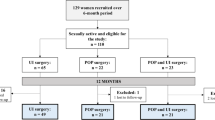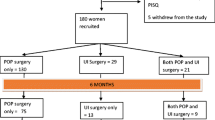Abstract
The objective of this study was to compare sexual function in women before and after surgery for urodynamic stress incontinence in the absence of pelvic organ prolapse. This was a prospective questionnaire survey. Fifty-four women undergoing surgery (tension-free vaginal tape/tension-free vaginal tape-obturator) for urodynamic stress incontinence with no evidence of detrusor overactivity or concomitant prolapse were assessed preoperatively and 6 months post operatively. Assessment was based on the Pelvic Organ Prolapse/Urinary Incontinence Sexual Questionnaire (PISQ), the International Consultation on Incontinence Questionnaire (ICIQ) and the Patient Global Impression of Improvement. Paired t-tests were used for comparing pre- and post-op scores and unpaired t-tests for comparing observations between groups. Spearman’s rank correlation was used for testing whether two numerically scored items were related, and McNemar test was used to compare pre- and postoperative responses to individual questions. ICIQ scores showed significant improvement after surgery (p < 0.001). Women completing PISQ were significantly younger (mean = 54) than those who did not (mean = 65; p < 0.001). The total PISQ score was better postoperatively (preoperative = 87.2, postoperative = 92.7; p < 0.001), with improvements in both the physical (preoperative = 31.0, postoperative = 35.2; p < 0.001) and partner-related domains (preoperative = 18.8, postoperative = 19.9; p = 0.002) but no improvement in behaviour emotive domains (preoperative = 37.3, postoperative = 37.6; p = 0.70). There was a reduction in episodes of coital incontinence postoperatively (preoperatively = 16/54, postoperatively = 39/54; p < 0.002). Previous vaginal surgery, oestrogen status of respondents and hysterectomy status did not affect the PISQ. Surgical correction of stress incontinence is associated with an improvement in sexual function.
Similar content being viewed by others
References
Jolleys JV (1988) Reported prevalence of urinary incontinence in women in a general practice. Br Med J (Clin Res Ed) 296:1300–1302
Fultz NH, Burgio K, Diokno AC, Kinchen KS, Obenchain R, Bump RC (2003) Burden of stress urinary incontinence for community-dwelling women. Am J Obstet Gynecol 189:1275–1282
Kelleher CJ, Cardozo LD, Khullar V, Salvatore S (1997) A new questionnaire to assess the quality of life of urinary incontinent women. Br J Obstet Gynaecol 104:1374–1379
Kizilkaya BN, Yalcin O, Ayyildiz EH, Kayir A (2005) Effect of urinary leakage on sexual function during sexual intercourse. Urol Int 74:250–255
Aslan G, Koseoglu H, Sadik O, Gimen S, Cihan A, Esen A (2005) Sexual function in women with urinary incontinence. Int J Impot Res 17:248–251
Mazouni C, Karsenty G, Bretelle F, Bladou F, Gamerre M, Serment G (2004) Urinary complications and sexual function after the tension-free vaginal tape procedure. Acta Obstet Gynecol Scand 83:955–961
Rogers RG, Kammerer-Doak D, Darrow A, Murray K, Olsen A, Barber M, et al (2004) Sexual function after surgery for stress urinary incontinence and/or pelvic organ prolapse: a multicenter prospective study. Am J Obstet Gynecol 191:206–210
Yeni E, Unal D, Verit A, Kafali H, Ciftci H, Gulum M (2003) The effect of tension-free vaginal tape (TVT) procedure on sexual function in women with stress urinary incontinence. Int Urogynecol J Pelvic Floor Dysfunct 14:390–394
Lemack GE, Zimmern PE (2000) Sexual function after vaginal surgery for stress incontinence: results of a mailed questionnaire. Urology 56:223–227
Ghezzi F, Serati M, Cromi A, Uccella S, Triacca P, Bolis P (2005) Impact of tension-free vaginal tape on sexual function: results of a prospective study. Int Urogynecol J Pelvic Floor Dysfunct 17:54–59
Elzevier HW, Venema PL, Nijeholt AA (2004) Sexual function after tension-free vaginal tape (TVT) for stress incontinence: results of a mailed questionnaire. Int Urogynecol J Pelvic Floor Dysfunct 15:313–318
Glavind K, Tetsche MS (2004) Sexual function in women before and after suburethral sling operation for stress urinary incontinence: a retrospective questionnaire study. Acta Obstet Gynecol Scand 83:965–968
Weber AM, Walters MD, Piedmonte MR (2000) Sexual function and vaginal anatomy in women before and after surgery for pelvic organ prolapse and urinary incontinence. Am J Obstet Gynecol 182:1610–1615
Maaita M, Bhaumik J, Davies AE (2002) Sexual function after using tension-free vaginal tape for the surgical treatment of genuine stress incontinence. BJU Int 90:540–543
Shah SM, Bukkapatnam R, Rodriguez LV (2005) Impact of vaginal surgery for stress urinary incontinence on female sexual function: is the use of polypropylene mesh detrimental? Urology 65:270–274
Bump RC, Mattiasson A, Bo K, Brubaker LP, DeLancey JO, Klarskov P, et al (1996) The standardization of terminology of female pelvic organ prolapse and pelvic floor dysfunction. Am J Obstet Gynecol 175:10–17
Avery K, Donovan J, Peters TJ, Shaw C, Gotoh M, Abrams P (2004) ICIQ: a brief and robust measure for evaluating the symptoms and impact of urinary incontinence. Neurourol Urodyn 23:322–330
Rogers RG, Kammerer-Doak D, Villarreal A, Coates K, Qualls C (2001) A new instrument to measure sexual function in women with urinary incontinence or pelvic organ prolapse. Am J Obstet Gynecol 184:552–558
Yalcin I, Bump RC (2003) Validation of two global impression questionnaires for incontinence. Am J Obstet Gynecol 189:98–101
Helstrom L, Nilsson B (2005) Impact of vaginal surgery on sexuality and quality of life in women with urinary incontinence or genital descensus. Acta Obstet Gynecol Scand 84:79–84
Hartmann U, Philippsohn S, Heiser K, Ruffer-Hesse C (2004) Low sexual desire in midlife and older women: personality factors, psychosocial development, present sexuality. Menopause 11:726–740
Acknowledgement
Our sincere thanks to our patients who took the time to complete these questionnaires, and Chris Foy (trust Statistician for Worcestershire Acute Hospital NHS Trust) who analysed the data and helped us interpret the results.
Author information
Authors and Affiliations
Corresponding author
Rights and permissions
About this article
Cite this article
Jha, S., Moran, P., Greenham, H. et al. Sexual function following surgery for urodynamic stress incontinence. Int Urogynecol J 18, 845–850 (2007). https://doi.org/10.1007/s00192-006-0245-0
Received:
Accepted:
Published:
Issue Date:
DOI: https://doi.org/10.1007/s00192-006-0245-0




